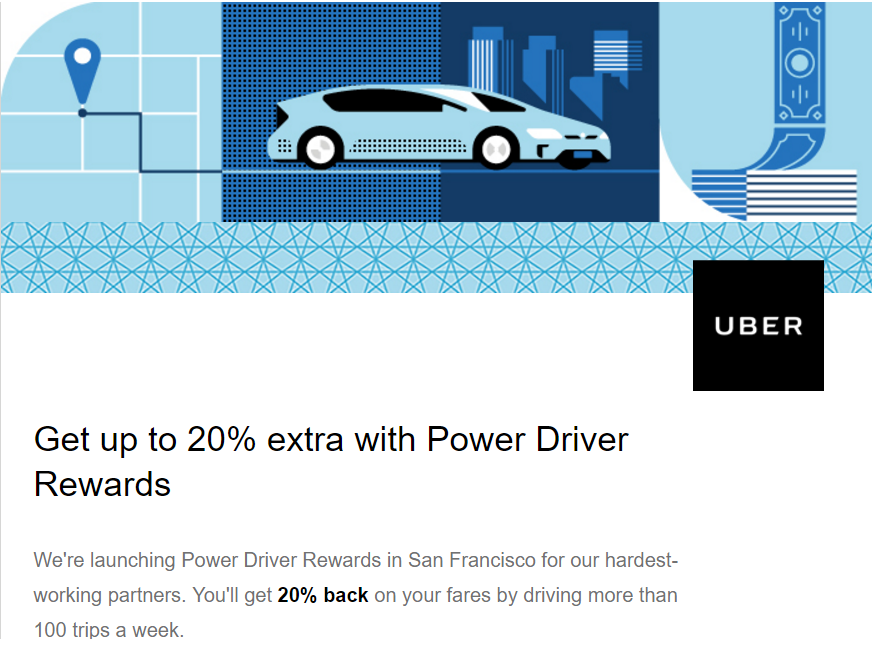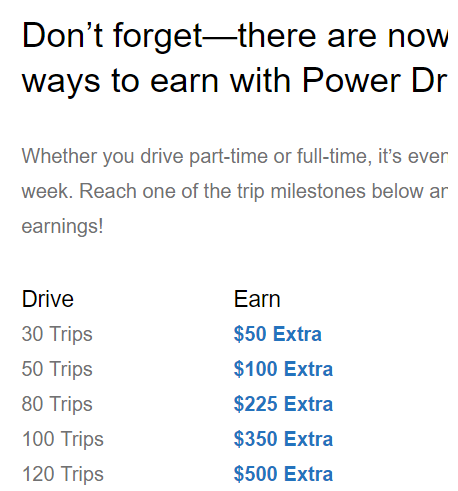Last week, Harry talked about how Uber is giving away a ton of money via promotions to its drivers in Los Angeles. Today I am following up on that topic to discuss how competition between Uber and Lyft is heating up, and how that can benefit power drivers.
I think this is an important topic because it may be signaling that the latest price-cuts have had a negative effect on driver supply and service reliability. Presently, Lyft and Uber are effectively waging a war for driver supply throughout the Bay Area by wielding an arsenal of promotions and bonuses to get drivers to drive exclusively on their side.
So why is this important to every driver? Well for one, what happens in SF and LA is often a precursor for what gets rolled out to the rest of the country. These markets often act as a guinea pig and a sort of proving ground to test what will work everywhere else. SF acts as the densely populated urban test, while LA acts as the sprawling suburban test.
Right now, these promotions are likely being tested on us before they are rolled out to you.
The Competition For Driver Supply In San Francisco
In February, Uber announced a Power Driver Rewards program that was eerily similar to Lyft’s Power Driver Bonus. It was so similar in fact, that Uber almost forgot to rename it. A few days later, Uber also announced that they were also raising minimum fares for drivers (to exactly the same as Lyft’s minimum fare). And Lyft responded by lowering their requirements for the Power Driver Bonus in light of Uber’s version being easier to achieve.

On top of all of that, both companies raised the driver referral bonus to $750 within a week of each other. From there, both companies began to offer random promotions such as guaranteed prime-time, hourly guarantees, $100 for your driver summary, $2 extra per ride on top of Power Driver Rewards, an Uber water bottle, guaranteed tips on Lyft Line, and a bunch of other stuff I forgot or didn’t get the email for.
Now I have seen a lot of promotions over the past couple years, but nothing like this before. Clearly, many drivers benefited from the resulting deluge of money. Others were frustrated when they didn’t qualify for the promotions or weren’t invited.
All we know for certain as to why this is going down is that they both REALLY want drivers. However, many drivers suspect that Uber is making a tactical move towards Lyft’s comparable market share in San Francisco, or that they are trying to recoup their loss of drivers after price-cuts. Maybe a little of both.
This all seems to indicate to me that there is a shortage of drivers after the latest round of price-cuts. The reality of driving for $0.85/mile is starting to sink in resulting in lower driver supply, increased surge and poorer quality rides for passengers. It’s pretty hard to survive on $0.85/mile unless there is constant surge, and you drive an indestructible Prius.
Related Article: How much does it really cost to be a rideshare driver?
The Catalyst: Lyft’s Power Driver Bonus
Many of you are familiar with Lyft’s Power Driver Bonus. It has seen several iterations and a bit of evolution (and yes, I still think the 2011 requirement is stupid). Regardless, it has been the single biggest thing that Lyft loyalists could always point towards and say “See, they care more about their drivers than Uber!” Sure, the partnerships, tips and Express Pay are really nice, but PDB is the centerpiece. With thinner margins over the last few years, that extra 20% and tips make a big difference.
Want to Get Paid Daily With Uber? Try DailyPay
The result is that it has had a slow and creeping effect on drawing over full-time drivers from Uber and turning them into brand evangelists for Lyft. Many frustrated Uber drivers have even told their Uber passengers how Lyft treats them better by allowing them to earn back their commissions – resigned to not care about how it affects their Uber rating.
When you combine that with Uber leading the way in lowering prices and raising commissions, you get a lot of drivers who feel outright contempt against Uber. Contempt is very hard to remove.
The Empire Strikes Back: Uber Announces Power Driver (Not A Bonus) Rewards

In late February, Uber announced their own version of the Power Driver Bonus, subtly titled Power Driver Rewards. The program is presently being piloted in San Francisco, and it does all the same stuff as Lyft’s PDB. It will pay the driver back between 10% and 20% of fares after they do a certain number of rides in a 2011 or newer car, and you have to meet similar metrics.
However, it is easier to reach as it does not have any “Peak Ride” requirements (for now). It also requires a lower Acceptance Rate (75% vs 90%) and has other offers stacking on-top of it at times. When it launched, it had a lower ride requirement than Lyft’s PDB, forcing Lyft to lower their ride requirement a week later.
Uber’s Second Version: Power Driver Plus
Uber is now testing what they’re calling “Power Driver Plus” which pays out a cash bonus based on the number of rides a driver gives.
It is their own take on a power driver program and seems to be based off of the average a driver would have earned back under the Power Driver Rewards program.
This is being tested in both San Francisco and Los Angeles. Uber is trying this version out to see if they could use the lower tiers and trip requirements to get part-time drivers onto their platform or on the road.
Will They Offer Rewards For Power Drivers In Other Markets?
We have no word yet on whether Uber will expand these incentives into other markets. I imagine that if Uber sees that these promotions do well in San Francisco and Los Angeles that they will fine tune them and deploy them to other markets where it makes the most sense. Conversely, if they have little to no effect on increasing their driver supply, they may not bother.
If Uber is simply trying to troll on Lyft, then I would speculate we’ll see Uber’s Power Driver programs appear where Uber and Lyft are most competitive. Austin, Boston, New York, Chicago, and Seattle being a few. Meanwhile, other markets may see watered down versions or none at all.
Is All Of This Sustainable?
The Power Driver Rewards and Power Driver Bonus are sustainable in that both companies still collect a service fee multiplied by the volume of rides for each driver. Furthermore, they still collect that 5% from the majority of drivers who are now on 25% commission structures. Most importantly, the majority of drivers are still part-time and won’t qualify for either version, which will leave only a minority of drivers to collect the bonus. So I can see PDB and PDR being a sustainable program, especially since Lyft has managed to pull it off over the last few years despite pressure from investors to get rid of it.
The Big Theme
A lot of these incentives are very expensive for Uber. They have always been adamant about taking their cut from drivers. So to see them offer something they have traditionally been so fundamentally against is a clear indicator that they are experiencing shrinkage in driver supply after the latest price cuts. Many of those who still drive after cuts seem to be driving less or looking for a different job altogether.
I don’t think they would have just rolled these programs out because they are nice or had some sudden shift in philosophy about how they treat their drivers as much as they are facing the harsh realization that drivers are angry, leaving in droves, and not sticking around for very long even after they have been recruited. This is likely placing pressure on Uber to spend a lot more money to influence driver supply. Something that is inherently unsustainable.
My Take
I think it is truly great that we are seeing this sort of competition for drivers in San Francisco and Los Angeles. It’s about time we heard some good news. My hope is that it ends up being a sort of turning point for drivers. A realization that the network effect of rideshare is bound by the economics and physics of the real-word, that you cannot drive a car for $0.85/mile forever. So Power Driver Rewards/Plus is a good step in the right direction.
My biggest worry as a driver is that this is only meant to act as a temporary trolling operation against Lyft, only to disappear when Uber gains the upper hand again in driver supply. This could lead to prices that get slashed so we can be “earning more than ever.”
I realize that my tone here sounds pretty skeptical of Uber. I mean, here we have Uber initiating something that is undoubtedly great for drivers: starting a competition for driver supply with rewards based on merit, which forces Lyft to up the ante in the process.
It’s just after relentless price-cuts over the last few years, after watching how that has hurt a lot of my friends, after seeing people spend the weekend sleeping in their Prius in a Starbuck’s parking lot, I have a right to be skeptical about their intentions.
Drivers, what do you think about Uber’s launching of Power Driver Rewards and how it stacks up with Lyft’s program?
-Christian @ RSG





